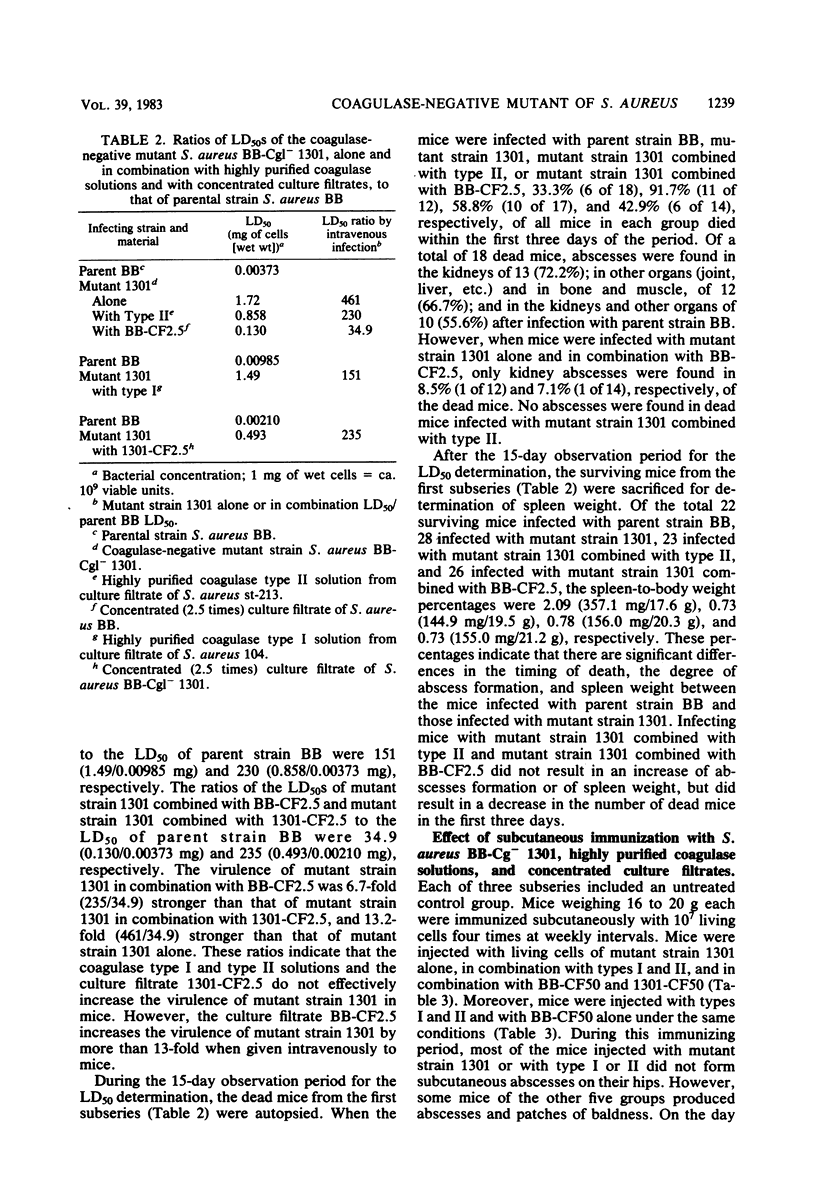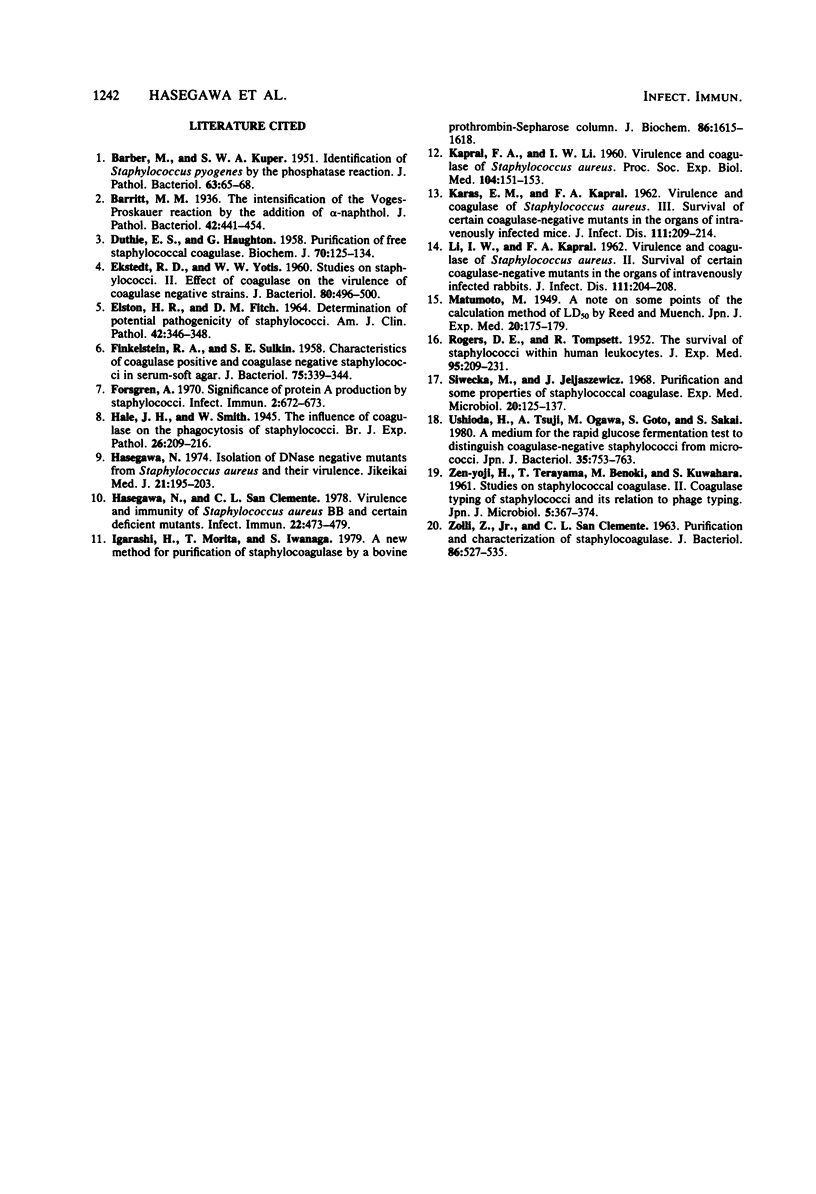Abstract
The virulence of the coagulase-deficient mutant BB-Cgl- 1301 (50% lethal dose [LD50] for mice by the intravenous route) was compared with that of its parental strain, Staphylococcus aureus BB. The BB strain produced free coagulase of serotype I, whereas the mutant 1301 did not. Mice were infected with strain 1301, alone or in combination with a highly purified coagulase type I or type II solution, or with concentrated culture filtrates of parent strain BB or mutant strain 1301. The ratios of the LD50S of 1301 and its combinations to that of BB ranged from 34.9 to 461. Combining strain 1301 with a concentrated culture filtrate of BB (BB-CF2.5) was the most effective for enhancement of its virulence. When mice were infected with a combination of strain 1301 and BB-CF2.5, the LD50 of strain 1301 (1.72 mg of cells [wet weight]) was decreased to 0.13 mg (1.3 x 10(8) CFU). This LD50 yielded the smallest ratio, 34.9, as compared with the LD50 of BB (0.00373 mg). In contrast, when the mice subcutaneously immunized with strain 1301 and BB-CF50 were intravenously challenged by strain BB, the LD50 for the immunized mice was 17.4 times the LD50 for the unimmunized control mice (0.0429 mg as compared with 0.00246 mg), indicating that combination was the most effective for enhancement of mouse immunization with strain 1301. However, combining strain 1301 with the highly purified sample of coagulase increased neither the virulence nor the immunizing power of mutant strain 1301.
Full text
PDF






Selected References
These references are in PubMed. This may not be the complete list of references from this article.
- BARBER M., KUPER S. W. A. Identification of Staphylococcus pyogenes by the phosphatase reaction. J Pathol Bacteriol. 1951 Jan;63(1):65–68. doi: 10.1002/path.1700630108. [DOI] [PubMed] [Google Scholar]
- DUTHIE E. S., HAUGHTON G. Purification of free staphylococcal coagulase. Biochem J. 1958 Sep;70(1):125–134. doi: 10.1042/bj0700125. [DOI] [PMC free article] [PubMed] [Google Scholar]
- EKSTEDT R. D., YOTIS W. W. Studies on staphylococci. II. Effect of coagulase on the virulence of coagulase negative strains. J Bacteriol. 1960 Oct;80:496–500. doi: 10.1128/jb.80.4.496-500.1960. [DOI] [PMC free article] [PubMed] [Google Scholar]
- ELSTON H. R., FITCH D. M. DETERMINATION OF POTENTIAL PATHOGENICITY OF STAPHYLOCOCCI. Am J Clin Pathol. 1964 Oct;42:346–348. doi: 10.1093/ajcp/42.4.346. [DOI] [PubMed] [Google Scholar]
- FINKELSTEIN R. A., SULKIN S. E. Characteristics of coagulase positive and coagulase negative staphylococci in serum-soft agar. J Bacteriol. 1958 Mar;75(3):339–344. doi: 10.1128/jb.75.3.339-344.1958. [DOI] [PMC free article] [PubMed] [Google Scholar]
- Forsgren A. Significance of protein a production by staphylococci. Infect Immun. 1970 Nov;2(5):672–673. doi: 10.1128/iai.2.5.672-673.1970. [DOI] [PMC free article] [PubMed] [Google Scholar]
- Hasegawa N., San Clemente C. L. Virulence and immunity of Staphylococcus aureus BB and certain deficient mutants. Infect Immun. 1978 Nov;22(2):473–479. doi: 10.1128/iai.22.2.473-479.1978. [DOI] [PMC free article] [PubMed] [Google Scholar]
- Igarashi H., Morita T., Iwanaga S. A new method for purification of staphylocoagulase by a bovine prothrombin-Sepharose column. J Biochem. 1979 Nov;86(5):1615–1618. doi: 10.1093/oxfordjournals.jbchem.a132679. [DOI] [PubMed] [Google Scholar]
- KAPRAL F. A., LI I. W. Virulence and coagulases of Staphylococcus aureus. Proc Soc Exp Biol Med. 1960 May;104:151–153. doi: 10.3181/00379727-104-25761. [DOI] [PubMed] [Google Scholar]
- LI I. W., KAPRAL F. A. Virulence and coagulases of Staphylococcus aureus. II. Survival of certain coagulase-negative mutants in the organs of intravenously infected rabbits. J Infect Dis. 1962 Nov-Dec;111:204–208. doi: 10.1093/infdis/111.3.204. [DOI] [PubMed] [Google Scholar]
- MATUMOTO M. A note on some points of calculation method of LD50 by Reed and Muench. Jpn J Exp Med. 1949 Sep;20(2):175–179. [PubMed] [Google Scholar]
- ROGERS D. E., TOMPSETT R. The survival of staphylococci within human leukocytes. J Exp Med. 1952 Feb;95(2):209–230. doi: 10.1084/jem.95.2.209. [DOI] [PMC free article] [PubMed] [Google Scholar]
- Ushioda H., Tsuji A., Ogawa M., Goto S., Sakai S. [A medium for the rapid glucose fermentation test to distinguish coagulase-negative Staphylococci from Micrococci (author's transl)]. Nihon Saikingaku Zasshi. 1980 Nov;35(6):753–763. [PubMed] [Google Scholar]
- ZEN-YOJI H., TERAYAMA T., BENOKI M., KUWAHARA S. Studies on staphylococal coagulase. II. Coagulase typing of staphylococci and its relation to phage typing. Jpn J Microbiol. 1961 Jul;5:367–374. [PubMed] [Google Scholar]
- ZOLLI Z., Jr, SANCLEMENTE C. L. PURIFICATION AND CHARACTERIZATION OF STAPHYLOCOAGULASE. J Bacteriol. 1963 Sep;86:527–535. doi: 10.1128/jb.86.3.527-535.1963. [DOI] [PMC free article] [PubMed] [Google Scholar]


